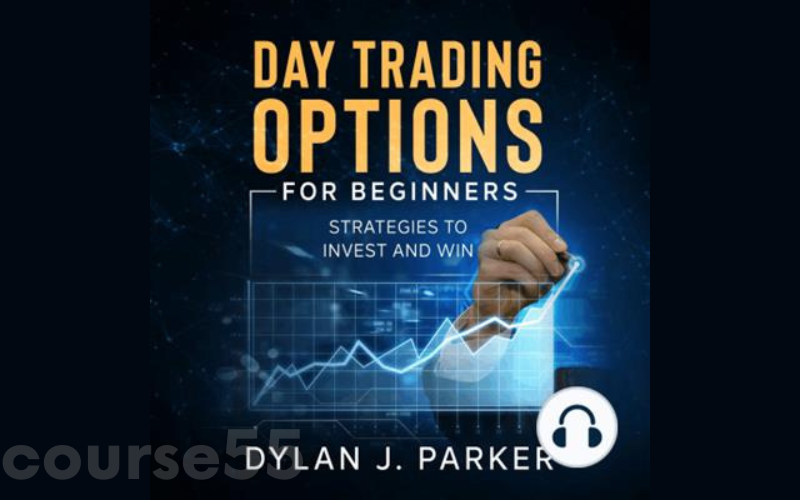DAY TRADING OPTIONS For Beginners: Strategies to INVEST and WIN By Dylan Parker
$5.00
Day trading options for beginners: Strategies to invest and win
Content Proof:
Navigating the world of day trading options can feel like stepping into an intricate maze where every turn could yield either fortune or folly. Dylan J. Parker’s audiobook, Day Trading Options for Beginners: Strategies to Invest and Win, serves as a lighthouse for newcomers lost in this complex domain. With over four hours of guidance narrated by Douglas Wilkin and Peter Seymour, this resource caters specifically to beginners eager to comprehend the fundamentals of options trading. Much like learning to ride a bicycle, it’s critical to take your time, absorb the lessons, and gradually build your understanding before speeding down the trading path.
Parker encourages aspiring traders to adopt a long-term perspective, urging them not to succumb to the intoxicating banter of quick riches. Rather, the journey of day trading should be seen as a marathon filled with strategy, patience, and a commitment to continual learning.
Understanding Options Trading
Before diving into the strategies of day trading, it’s essential to grasp what options trading entails. At its core, options trading is a financial derivative that provides the buyer the right, but not the obligation, to buy or sell an asset at a predetermined price within a specific timeframe. Imagine having a ticket to a concert; you have the option to attend or sell it to someone else without the compulsion to show up yourself. This unique characteristic is what makes options appealing to many traders.
Key Concepts in Options Trading
- Strike Price: This is the price at which the option can be exercised. It’s the tipping point that determines whether the option will be profitable.
- Expiration Date: Options do not last forever; they expire, and understanding this timeframe is crucial for strategy formulation.
- Call and Put Options: A call option gives the holder the right to buy, while a put option grants the right to sell the underlying asset. These two types form the bedrock of any options trading strategy.
To visualize these concepts more clearly, here’s a concise table summarizing essential terms:
| Term | Description |
| Strike Price | The predetermined price at which you can buy or sell the underlying asset. |
| Expiration Date | The date on which the option contract becomes void if not exercised. |
| Call Option | A right to purchase the underlying asset at the strike price before expiration. |
| Put Option | A right to sell the underlying asset at the strike price before expiration. |
Crafting Your Trading Strategy
Successful trading is not just a matter of luck; it requires a well-thought-out strategy. Parker emphasizes the importance of crafting a trading strategy that aligns with your financial goals and risk tolerance. Here are several key strategies to consider:
1. Bull and Bear Spreads
These strategies allow traders to capitalize on expected market movements. In essence, a bull spread is utilized when you believe the market will rise, while a bear spread is employed when anticipating a decline. These spreads limit both potential gains and losses, providing a cushion for beginners still learning the ropes.
2. Long Calls and Puts
Long calls are ideal when you expect a significant upward movement in price, whereas long puts can be advantageous when you anticipate a drop. These strategies highlight the importance of market timing and trend analysis, which Parker painstakingly covers in his audiobook.
3. Risk Management Techniques
As with any investment endeavor, risk management is paramount. Parker underscores the necessity of stop-loss orders, which can help limit losses in volatile markets. Setting clear profit targets and loss limits allows traders to preserve their capital and avoid emotional decision-making.
Managing the Psychological Aspects of Trading
Trading is not solely about numbers; it’s also a game of psychology. The emotional rollercoaster of highs and lows can lead to impulsive decisions that may jeopardize a trader’s success. Parker discusses techniques to cultivate a resilient trading mindset essential for both beginners and seasoned traders alike.
Emotional Discipline
A successful trader must develop emotional discipline akin to that of a seasoned warrior on the battlefield. This includes controlling fear, greed, and anxiety while making trading decisions. Parker suggests practices such as setting predefined trading rules and adhering to them without exception. By doing so, traders minimize the risk of making emotionally driven choices that could derail their long-term objectives.
Continuous Learning and Adaptation
The market is ever-evolving, and so should a trader’s approach. Parker encourages ongoing education and adaptation to changing market conditions. Engaging with forums, attending workshops, and studying market trends can keep you ahead of the curve, much like an athlete adjusting their training based on performance feedback. One study published in the Journal of Behavioral Finance demonstrated that traders who applied continuous learning strategies were significantly more successful over time compared to their less-informed counterparts.
Risks Associated with Day Trading
While the potential for profit in day trading options is enticing, it’s embedded with risks that must not be overlooked. Parker highlights several pitfalls that beginners should be aware of to mitigate losses effectively.
Market Volatility
The stock market’s inherent volatility can lead to swift price changes that, while offering opportunities, can also result in drastic losses. Understanding how to navigate this volatility is crucial. For instance, practicing with “paper trading” (simulated trading without real money) allows beginners to familiarize themselves with market dynamics before committing actual funds.
Over-Leverage
Many novice traders fall into the trap of over-leveraging their accounts, driven by the allure of high potential returns. However, this often leads to significant losses. Risk management strategies, such as position sizing and awareness of margin requirements, can help safeguard against this common mistake.
Conclusion
In summary, Day Trading Options for Beginners: Strategies to Invest and Win by Dylan J. Parker unfurls an intricate tapestry of knowledge that equips novice traders with the necessary tools to embark on their trading journey. From fundamental concepts to advanced strategies and psychological insights, Parker’s comprehensive guide acts as both a mentor and a map, illuminating the often treacherous terrain of options trading. While the quest for profit in day trading may be fraught with challenges, a steadfast commitment to learning, strategy, and emotional discipline can pave the way for long-term success. As you delve into this engaging audiobook, remember that patience and perseverance are your allies.
Frequently Asked Questions:
Business Model Innovation: We use a group buying strategy that enables participants to share costs and access popular courses at lower prices. This approach helps individuals with limited financial resources, although it may raise concerns among content creators regarding distribution methods.
Legal Considerations: Our operations navigate complex legal issues. While we do not have explicit permission from course creators to resell their content, there are no specific resale restrictions mentioned at the time of purchase. This lack of clarity allows us to offer affordable educational resources.
Quality Control: We guarantee that all course materials provided are identical to those offered directly by the creators. However, please note that we are not official providers. As a result, our services do not include:
– Live coaching calls or sessions with the course author
– Access to exclusive author-controlled groups or portals
– Membership in private forums
– Direct email support from the author or their team
Our goal is to make education more accessible by offering these courses independently, without the additional premium services available through official channels. We appreciate your understanding of our unique approach.
Be the first to review “DAY TRADING OPTIONS For Beginners: Strategies to INVEST and WIN By Dylan Parker” Cancel reply
You must be logged in to post a review.



















Reviews
There are no reviews yet.